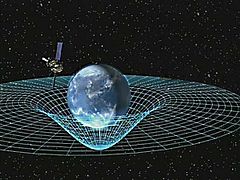| Part of a series on |
| Spacetime |
|---|
 |
In theoretical physics, Lovelock's theory of gravity (often referred to as Lovelock gravity) is a generalization of Einstein's theory of general relativity introduced by David Lovelock in 1971.[1] It is the most general metric theory of gravity yielding conserved second order equations of motion in an arbitrary number of spacetime dimensions D. In this sense, Lovelock's theory is the natural generalization of Einstein's general relativity to higher dimensions. In three and four dimensions (D = 3, 4), Lovelock's theory coincides with Einstein's theory, but in higher dimensions the theories are different. In fact, for D > 4 Einstein gravity can be thought of as a particular case of Lovelock gravity since the Einstein–Hilbert action is one of several terms that constitute the Lovelock action.
- ^ Lovelock, David (1971). "The Einstein Tensor and Its Generalizations". Journal of Mathematical Physics. 12 (3). AIP Publishing: 498–501. Bibcode:1971JMP....12..498L. doi:10.1063/1.1665613. ISSN 0022-2488.